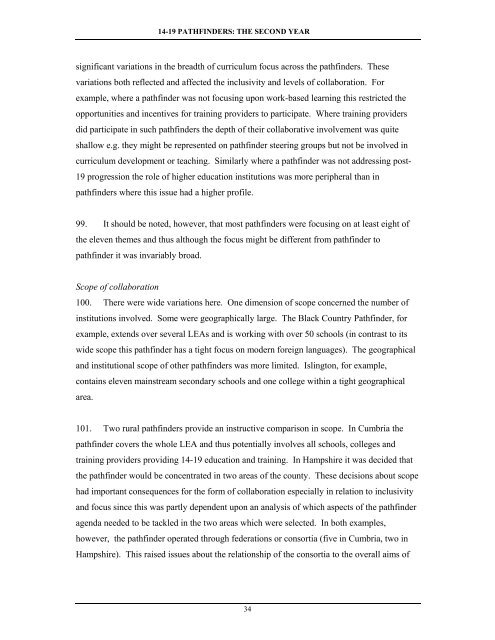Collaborative Approaches to 14-19 Provision - Communities and ...
Collaborative Approaches to 14-19 Provision - Communities and ...
Collaborative Approaches to 14-19 Provision - Communities and ...
- No tags were found...
Create successful ePaper yourself
Turn your PDF publications into a flip-book with our unique Google optimized e-Paper software.
<strong>14</strong>-<strong>19</strong> PATHFINDERS: THE SECOND YEARsignificant variations in the breadth of curriculum focus across the pathfinders. Thesevariations both reflected <strong>and</strong> affected the inclusivity <strong>and</strong> levels of collaboration. Forexample, where a pathfinder was not focusing upon work-based learning this restricted theopportunities <strong>and</strong> incentives for training providers <strong>to</strong> participate. Where training providersdid participate in such pathfinders the depth of their collaborative involvement was quiteshallow e.g. they might be represented on pathfinder steering groups but not be involved incurriculum development or teaching. Similarly where a pathfinder was not addressing post-<strong>19</strong> progression the role of higher education institutions was more peripheral than inpathfinders where this issue had a higher profile.99. It should be noted, however, that most pathfinders were focusing on at least eight ofthe eleven themes <strong>and</strong> thus although the focus might be different from pathfinder <strong>to</strong>pathfinder it was invariably broad.Scope of collaboration100. There were wide variations here. One dimension of scope concerned the number ofinstitutions involved. Some were geographically large. The Black Country Pathfinder, forexample, extends over several LEAs <strong>and</strong> is working with over 50 schools (in contrast <strong>to</strong> itswide scope this pathfinder has a tight focus on modern foreign languages). The geographical<strong>and</strong> institutional scope of other pathfinders was more limited. Isling<strong>to</strong>n, for example,contains eleven mainstream secondary schools <strong>and</strong> one college within a tight geographicalarea.101. Two rural pathfinders provide an instructive comparison in scope. In Cumbria thepathfinder covers the whole LEA <strong>and</strong> thus potentially involves all schools, colleges <strong>and</strong>training providers providing <strong>14</strong>-<strong>19</strong> education <strong>and</strong> training. In Hampshire it was decided thatthe pathfinder would be concentrated in two areas of the county. These decisions about scopehad important consequences for the form of collaboration especially in relation <strong>to</strong> inclusivity<strong>and</strong> focus since this was partly dependent upon an analysis of which aspects of the pathfinderagenda needed <strong>to</strong> be tackled in the two areas which were selected. In both examples,however, the pathfinder operated through federations or consortia (five in Cumbria, two inHampshire). This raised issues about the relationship of the consortia <strong>to</strong> the overall aims of34
















